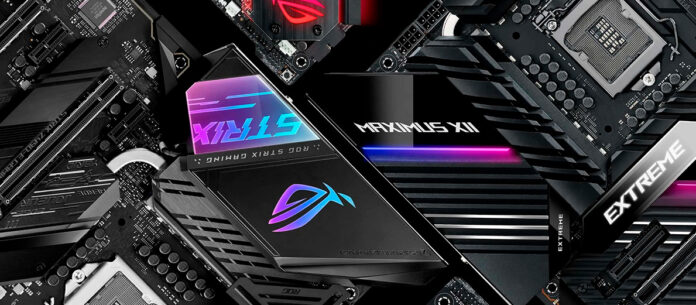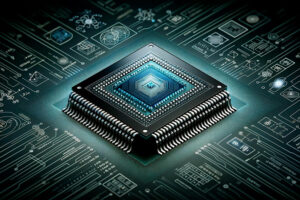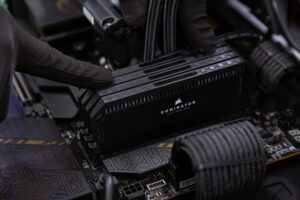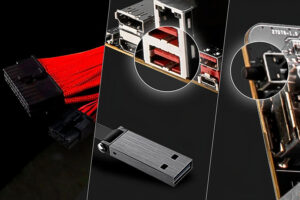VRM zone throttling, unstable RAM operation, lack of USB ports, black screen when turning on the PC due to an outdated BIOS version – all this occurs due to an incorrectly selected motherboard. We tell you how to avoid mistakes, what to look for when choosing, which characteristics are really important and which can be skipped, and how to choose a board that will reveal the power of all PC components.
Why the Motherboard Is More Important Than It Seems
- Reduced graphics card performance.
If the card is equipped with an outdated version of PCI Express (for example, 3.0 instead of 4.0 or 5.0), a modern graphics accelerator will not work at full capacity. - Overheating of the VRM zone (processor power subsystem).
When installing a powerful processor on a board with a simple power scheme, the VRM zone overheats. This leads to lags, freezes, and decreased PC performance. - Unstable operation of RAM.
Not all boards cope equally well with high-frequency RAM. Sometimes, even the declared support for 6000+ MHz does not guarantee stability without manual adjustment of timings and voltage. - Problems with updating the BIOS firmware.
Some motherboards do not support installing a new processor “out of the box” without updating the BIOS, and without the old processor, it is impossible to do this. - Low speed of SSD drives.
If there are not enough PCI-E lanes, connecting one drive may slow down another. For example, installing a second M.2 SSD may cut the speed of the first. - Impossibility of future upgrades.
Some boards are limited by power, BIOS, or PCI-E version, which means that you won’t be able to install more powerful and modern components in the future. And even if you do, they won’t work at full capacity.
When choosing a motherboard, there are a lot of small but critical nuances that are important to know in advance. Otherwise, problems with performance and compatibility are inevitable.
Important characteristics of motherboards
Socket: Where it all begins
The socket is the slot into which the processor is installed. It determines which CPU models can be physically installed on the board. If the socket does not match, the processor will not be installed.
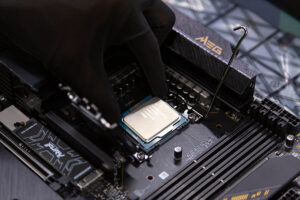
The following platforms are relevant for 2025:
- Intel LGA 1700. Suitable for 12th, 13th, and 14th generation Intel Core processors. Still widely used in new builds.
- Intel LGA 1851. New platform for Intel Arrow Lake processors (15th generation). Gradually replacing LGA 1700 and suitable for the latest builds.
- AMD AM5. Universal socket for Ryzen 7000, 8000, and 9000. AMD promises long-term support for AM5 until at least 2027.
- AMD AM4. Previous generation. Still relevant for budget solutions and upgrades of old systems, but no new processors are released for it.
Chipset: What does it give, and why is it so important
The chipset is the “brain” of the motherboard. It directly affects such characteristics as:
- Number and versions of PCI-E lanes.
- Support for specific processor models.
- The power of the VRM zone and the quality of its cooling.
- Type of RAM and its overclocking capabilities.
- BIOS/UEFI features, including customization and update capabilities.
- The number of ports and connectors for connecting additional devices.
If you make a mistake in choosing a chipset, you may have big problems. For example, the selected processor may not work, high-frequency RAM will not start with the required characteristics, and due to the lack of the necessary connectors, you will not be able to connect fans with addressable RGB lighting, and so on.
Intel: Chipset Letters and What They Mean
The H-series (e.g. H610, H810) is are budget solution, very limited in features and capabilities. Such boards are designed for entry-level processors (Intel Core i3, Core i5, and Ultra 5).
- A small number of PCI-E lanes.
- Fewer USB ports and connectors for connection.
- There is no support for overclocking the processor and RAM.
- Weak VRM zone, not designed to work with powerful processors.
B-series (e.g., B760, B860) is the middle class. It is considered the golden mean for gaming and work tasks. Such boards are suitable for fairly productive processors (Intel Core i5, Core i7, Ultra 5, Ultra 7).
- A large number of PCI-E lanes.
- There is no possibility of overclocking the processor.
- Latest PCI-E versions on many models.
- A large number of ports for peripherals and storage devices.
- Excellent price/features/performance ratio.
Z-series (e.g., Z790, Z890) is a flagship solution designed for enthusiasts and those who want maximum performance. Such boards can handle even the most powerful processors (Intel Core i9 and Ultra 9).
- Maximum number of PCI-E lanes.
- Full support for overclocking the processor and memory.
- A rich set of ports, connectors, and interfaces.
- Best VRM power and cooling for powerful processors.
AMD: Chipset Letters and What They Mean
The A-series (e.g., A620) is the entry level, but it is not as limited as Intel’s H-chipset. These boards are suitable for entry-level processors (AMD Ryzen 3, Ryzen 5).
- There is no support for processor overclocking.
- Limited number of ports, connectors, and PCI-E lanes.
- A weak power supply system that can’t handle powerful processors.
B-series (e.g., B650, B850) is the mid-range, considered the best value for money. These boards are suitable for powerful processors (AMD Ryzen 7 and sometimes Ryzen 9 if the board has a reinforced VRM zone).
- Support for processor and memory overclocking.
- Supports a large number of PCI-E lanes.
- A large number of connectors, ports, and sockets.
- Improved power supply system (some models can even handle Ryzen 9).
X-series (e.g,. X670E, X870E) is the flagship line. Such boards easily cope with the most powerful processors (AMD Ryzen 9).
- Reinforced VRM area with efficient cooling.
- Supports the maximum number of PCI-E lanes.
- Support for overclocking the processor and RAM.
- A huge number of connectors, sockets, and ports.
ATX, mATX, ITX – what’s the catch with form factors and what’s right for you

- microATX (24.4 x 24.4 cm) – more compact than ATX, but retains most of the features. Fits in most cases, including mini-tower.
- mini-ITX (17 × 17 cm) – ultra-compact format. Requires a special Mini-ITX case. Limited in ports, slots, and cooling.
- E-ATX (up to 30.5 × 33 cm) – an extended format for top-end systems. A large case is needed (usually Full-Tower). Used for flagship builds.
Always check if the case supports the required form factor of the board. If you take too big a motherboard, it simply won’t fit. And if it’s too small, there will be space, which looks unsightly. In addition, there may be problems with cooling and cable management.
It’s easy to find out the supported form factors of a motherboard: just Google the case name and go to the manufacturer’s website or any online store. These characteristics will always be indicated in the description.
Number of slots and type of supported RAM: pitfalls that are not talked about
Each board supports a specific type and frequency of RAM. Some models only work with DDR4, others with DDR5. For some models, the maximum frequency for DDR4 RAM is 3200 MHz; for others, 5000 MHz. The same for DDR5.
- The RAM type must match.
DDR4 and DDR5 are physically different standards. They are not compatible with each other, and no motherboard supports both types at the same time. Make sure that the memory and motherboard support each other. - Memory frequency depends on the chipset.
Many budget boards have a very limited maximum RAM frequency. Even if the modules support more, they simply won’t work at a high frequency due to motherboard limitations. - Not all motherboards with four slots can work stably with them.
Inexpensive models may have insufficient power supply, and two additional slots will either not start or reduce the stability of the system. - DDR5 can only work stably at a high frequency when two modules are installed.
If you install four strips, the frequency almost always decreases, especially without manual adjustment. This is a technical limitation of the DDR5 standard. - DDR4 works stably with four modules.
It does not have such problems with frequency.
Advice: if you are going to install DDR5 and do not want to mess with the settings, take 2 modules of the required volume at once. And if you are planning an upgrade, make sure that the board and processor work adequately with four strips.
PCI-E lanes: somewhere there won’t be enough speed, and somewhere nothing will work at all
PCI-E slots are not just “where to insert a video card and SSD”. Their number and version determine whether the device will work and at what speed.
- Version – this determines the data transfer speed (for example, 5.0 is faster than 4.0).
- Width – denoted as x16, x8, x4, or x1. This is the number of communication channels. The larger the “x”, the higher the speed.
- Video cards need an x16 slot.
This is the “widest” and fastest slot, which is usually the only one on the board. If you insert a video card into an x4 slot, it will work, but with reduced performance. - The PCI-E version of the video card and the connector on the board must match.
Otherwise, the performance of the graphics accelerator will decrease. Usually, the decrease is small (5-10%), but in some tasks it can be greater. - M.2 SSDs come in different forms.
Some drives use a PCI-E connection, while others use SATA III. If you insert a SATA III SSD into an M.2 slot with a PCI-E interface, the drive will not work. - Connecting additional devices may disable other slots or reduce their speed.
On budget boards, the number of PCI-E lanes is limited. For example, if you insert a second SSD with a PCI-E interface, the first one may be disabled or start working at a lower speed.
If you’re building a PC from scratch, don’t skimp on the motherboard. For example, a board that supports the latest PCI-E versions will make future upgrades easier.
VRM Zone: Why Power Phases Affect Stability and Performance

The VRM (Voltage Regulator Module) area is a set of controllers, drivers, MOSFETs, chokes, and capacitors. These components are needed to supply a smooth and stable voltage to the CPU, since it cannot operate directly from the power supply.
On any board, the VRM zone is located around the processor socket. It is easy to see: these are chips, “squares”, and cylindrical “towers”.
To reduce the load on the VRM zone, it is parallelized into several power phases. The more of them, the less load on each of them. This allows for reducing component temperatures, extending their service life, and protecting against overheating.
How many power phases are needed
- the presence and thickness of metal radiators;
- characteristics of the components used in the VRM zone.
For example, a board with top-end components and large metal heatsinks, but a small number of power phases, can work much better, more stably and with less heat than a board with a large number of power phases built on budget components without heatsinks.
- 4-6 phases is the minimum level. Suitable for office and the most budget gaming assemblies with processors like AMD Ryzen 3 or Intel Core i3.
- 6-10 phases – minimum for gaming and work systems. Supports stable operation of mid-range AMD Ryzen 5, Intel Core i5 and Ultra 5 processors.
- 10+ phases are the optimal solution for computers with powerful processors. For example, with top models Intel Core i5, Core i7, Core i9, Ultra 5, Ultra 7, Ultra 9, as well as AMD Ryzen 5, Ryzen 7 and Ryzen 9.
What happens if you install a powerful processor in a board with a weak VRM zone
- VRM Overheating:
Without enough phases and cooling, power system components begin to overheat, especially under load. - Throttling.
To avoid overheating, the board reduces the processor frequency. In games and programs, this manifests itself in the form of freezes, a drop in FPS and a decrease in overall performance. - Unstable operation.
Spontaneous reboots, errors during system startup, and application crashes are possible. - Accelerated wear of components.
Working at the limit can lead to rapid failure of VRM elements and breakdown of the entire board.
Even if the socket and chipset technically support a powerful processor, this does not mean that the board will cope with it. For powerful CPU models, choose a motherboard with a reinforced VRM zone and a large radiator – this is a guarantee of stable and long-lasting operation.
Metal heatsinks on the VRM area are a critical element that few people pay attention to.
To reduce the temperatures of VRM components, they are covered with metal radiators through thermal pads. The elements give off excess heat, and their operating temperatures are greatly reduced. This allows:
- protect the VRM area from overheating;
- extend the service life of components (the less heat, the less load).
Metal heatsinks are not just decorative elements near the socket. They are critical for stability. The more massive and thoughtful the cooling of the VRM zone, the more reliably the system will work under load. This is especially important for top processors (Intel Core i9, Ultra 9, AMD Ryzen 9), which consume a lot of energy and heavily load the VRM components.
BIOS version: a critical moment that everyone remembers too late
BIOS is the firmware of the motherboard that is responsible for starting the system and recognizing the processor. If the BIOS version is too old, the board may not recognize the new processor. The result is a black screen when turning on.
This is especially important when buying components separately. For example, if you take a modern AMD Ryzen 9000 processor, and a board with a B650 chipset, released back in the days of Ryzen 7000, then the new processor may not work. Despite the fact that the socket is the same.
- Choose a motherboard with the right BIOS version “out of the box”.
Some stores indicate which processors are supported without an update. You can also look at the list of supported CPUs on the board manufacturer’s website. There, you can always find the minimum BIOS version number for each processor model. - Choose a board with the BIOS Flashback function.
It works simply: you download the required BIOS version to a flash drive, insert it into the motherboard, connect the 20+4 Pin and 4+4 Pin (CPU) cables from the power supply to the board, and press the button to update the firmware. In a couple of minutes, the update will be completed, and the system will definitely work with the new processor. - Consider the chipset generation.
New chipsets (for example, Intel 800 series or AMD 800 series) are initially designed to work with new processors. They almost always have the latest BIOS version. This reduces the risk of incompatibility.
What else should you consider when choosing a motherboard?
- ARGB connectors.
If you have fans or a case with addressable RGB lighting, make sure that the board has the necessary 3-pin ARGB connectors. Without them, the lighting synchronization via software will not work. - Connector for a liquid cooling system.
Modern liquid cooling systems are connected via a special AIO_PUMP connector. If you don’t have one, you’ll have to use a regular CPU_FAN, which isn’t always convenient. It’s better to choose a board with a separate connector for liquid cooling. - Number and location of case FAN connectors.
Check if there are enough connectors for all the fans in the case, especially if there are more than 4 coolers. Conveniently located connectors will allow you to neatly route the cables. - Built-in Wi-Fi and Bluetooth.
For example, if you do not plan to use wired Internet, choose a board with a Wi-Fi module. Not all models have it. Especially in the mid-range and budget segments. - Number of USB ports and video outputs.
This is especially important for office and multimedia builds. If you plan to use the processor’s integrated graphics, make sure the board has HDMI or DisplayPort. - Diagnostic indicators or POST codes.
These elements greatly simplify diagnostics if the PC does not start. For example, if the yellow RAM indicator is on, it is clear that the problem is in the RAM and you need to change its settings in the BIOS. - Reinforced video card slot.
The metal reinforcement of the PCI-E x16 slot protects it from breaking if the video card is very heavy. However, in this case, it is still recommended to use a “holder stand” for the card.
Decide in advance what devices and components you will connect. Check if there are the necessary connectors on the board for them. Then there will be no surprises when assembling the PC. Everything will fit, work, and shine as it should.
How to Choose a Motherboard for a Gaming Computer: Summary
Choosing a motherboard is often more difficult than choosing a processor or video card. Motherboards have dozens of nuances: socket, chipset, power supply, memory support, slots, BIOS, form factor, connectors, and so on. If you miss even one of them, you can run into big problems.
- The socket must match the processor.
Not all motherboards support new CPUs, even if the sockets look the same or very similar. - The chipset determines the capabilities of the system.
It determines overclocking support, the number of PCI-E lines, interfaces, and connectors. - Processor power (VRM zone) is critical.
For powerful CPUs, choose boards with a multi-phase VRM zone and large metal heatsinks. - The form factor should match the case.
ATX, mATX, mini-ITX – always check the dimensions before buying. - RAM type and frequency.
Make sure the board supports the required standard (DDR4 or DDR5) and the stated frequency. - PCI-E is not just for graphics cards.
It is important to consider the version and number of lanes for SSDs, expansion cards, and future upgrades. - The BIOS version can be an issue.
Older boards may not boot with newer processors without a firmware update. - Necessary connectors on the board.
ARGB, USB-C, Wi-Fi, and connectors for liquid cooling – check the presence of everything you plan to use. - Additional little things are also important.
Diagnostic indicators, reinforced slots, WiFi, and Bluetooth are pleasant bonuses that are often forgotten.
Don’t buy a motherboard “on the side”. It’s the basis of the entire system. It’s better to spend a little time studying the characteristics and get a stable, fast, and reliable PC that you won’t have to fight over trifles.

